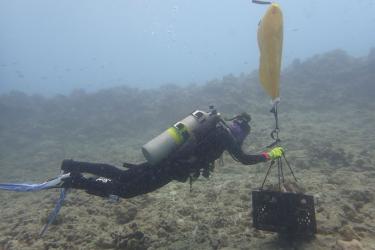The Hawaiian Islands Cetacean and Ecosystem Assessment Survey is a large-scale survey that assesses the abundance and habitat of whales, dolphins, and seabirds in Hawaiʻi. HICEAS is the only comprehensive study of its kind in the islands and takes place from July through December 2023. The survey covers approximately 1.8 million square nautical miles of waters around all Hawaiian Islands out to 200 nautical miles offshore including the Papahānaumokuākea Marine National Monument. Waters within this boundary are referred to as the U.S. Exclusive Economic Zone. Successfully studying this vast area requires collaboration. The Pacific Islands Fisheries Science Center and the Southwest Fisheries Science Center are carrying out this survey aboard two NOAA Ships, Oscar Elton Sette and Reuben Lasker.
Research and Technology
HICEAS 2023 is the fourth large-scale line-transect survey of its kind in the Exclusive Economic Zone surrounding Hawai‘i. It involves placing straight lines, or transects, across the study area to systematically collect data of whale and dolphin species for estimating abundance. This year’s survey is similar to the previous three surveys conducted in 2002, 2010, and 2017 and will include three major research components:
Visual Observations
These include photo-identification, biopsy sampling, and satellite tagging—will be used to find, identify, and count whales and dolphins to estimate their population size (abundance), which can feel like finding a needle in a haystack.
Passive Acoustic Monitoring
We will use towed hydrophone arrays and drifting recorders will detect and track animals. This monitoring can even help to identify certain species by the sounds they make.
Ecosystem Assessments
These will include seabird surveys and visual observations, measurement of oceanographic variables, and plankton tows. Daily conductivity, temperature, and depth assessments will provide important habitat information.
The survey will provide data for several management priorities including:
- Population and habitat information on the whale, dolphin, and seabird species in the Papahānaumokuākea Marine National Monument
- New abundance estimates for false killer whales in support of the False Killer Whale Take-Reduction Plan and estimates for all cetacean species as required under the Marine Mammal Protection Act
- Updated population abundance data and habitat extent for large whale, sea turtle, and seabird species listed under the Endangered Species Act
- Updated cetacean and seabird assessments used to inform sustainable bycatch rates in U.S. fisheries as required under the Marine Mammal Protection Act and Magnuson-Stevens Act
Partners
The data collected during HICEAS 2023 will contribute to the larger Pacific Marine Assessment Program for Protected Species plan. This program is a multi-agency partnership among NOAA Fisheries, the Bureau of Ocean Energy Management, and the U.S. Navy to collect data and produce abundance estimates for population assessments for species of shared management interest. The Southwest Fisheries Science Center will run survey operations aboard the NOAA Ship Reuben Lasker.
Join the Journey
For more than two decades the HICEAS effort has provided valuable information that has helped to shape how we care for our whales, dolphins, and seabirds. HICEAS 2023 looks forward to continuing this important legacy of research. Join us on the journey by following along on our map tour and social media updates!




